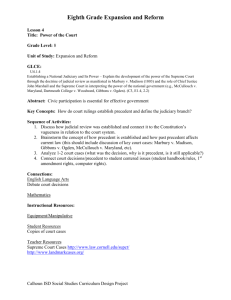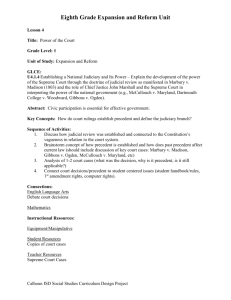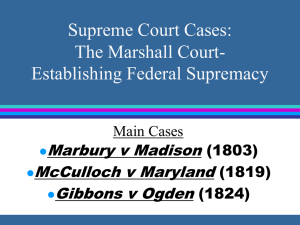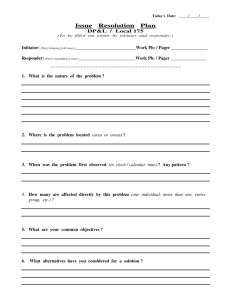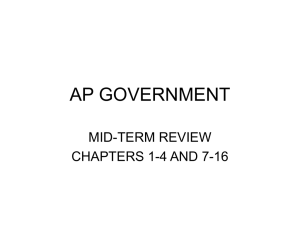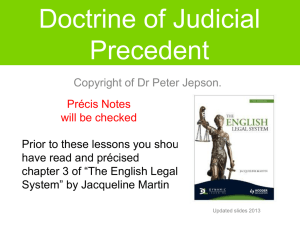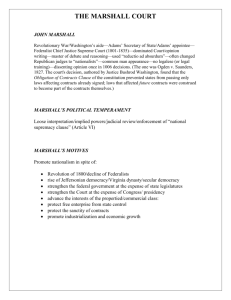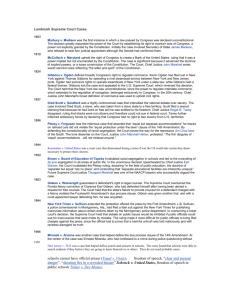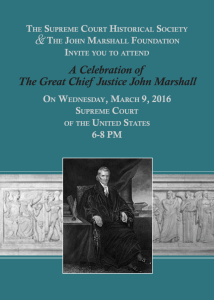USAP Supreme Court Review – Fill in the Correct
advertisement
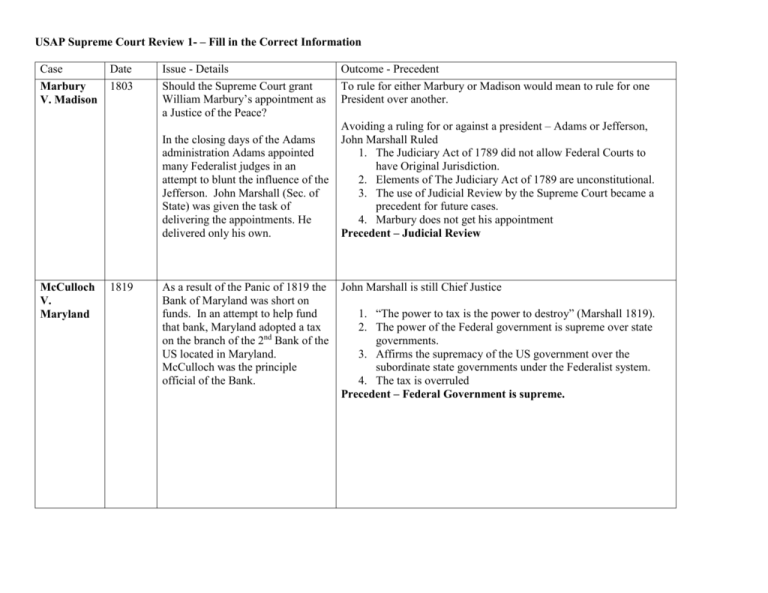
USAP Supreme Court Review 1- – Fill in the Correct Information Case Marbury V. Madison Date 1803 Issue - Details Should the Supreme Court grant William Marbury’s appointment as a Justice of the Peace? In the closing days of the Adams administration Adams appointed many Federalist judges in an attempt to blunt the influence of the Jefferson. John Marshall (Sec. of State) was given the task of delivering the appointments. He delivered only his own. McCulloch V. Maryland 1819 As a result of the Panic of 1819 the Bank of Maryland was short on funds. In an attempt to help fund that bank, Maryland adopted a tax on the branch of the 2nd Bank of the US located in Maryland. McCulloch was the principle official of the Bank. Outcome - Precedent To rule for either Marbury or Madison would mean to rule for one President over another. Avoiding a ruling for or against a president – Adams or Jefferson, John Marshall Ruled 1. The Judiciary Act of 1789 did not allow Federal Courts to have Original Jurisdiction. 2. Elements of The Judiciary Act of 1789 are unconstitutional. 3. The use of Judicial Review by the Supreme Court became a precedent for future cases. 4. Marbury does not get his appointment Precedent – Judicial Review John Marshall is still Chief Justice 1. “The power to tax is the power to destroy” (Marshall 1819). 2. The power of the Federal government is supreme over state governments. 3. Affirms the supremacy of the US government over the subordinate state governments under the Federalist system. 4. The tax is overruled Precedent – Federal Government is supreme. Gibbons V. Ogden Dred Scott V. Sanford 1824 1857 A dispute arose over the ability to conduct trade on NY waterways. Ogden had been granted an exclusive license by the State of NY. Gibbons – his former partnerhad obtained Federal permission to engage in trade on the same waterways. Ogden sued in the lower court and won on the idea that his license was issued first and that the states can regulate commerce within their borders. Gibbons appealed to the Supreme Court. Yes – John Marshall is still around. This is almost a revisit of the McCulloch case. The question remains - which authority is supreme, Federal or State? Many complicated details here. Scott originally belonged to John Emerson of Missouri. Emerson had taken Scott to the Free Territory of Illinois for a number of years. Upon his death Scott was transferred to Irene Sanford – his wife. A federal court later ruled that Scott should have been transferred to John Sanford – her brother because women could not own property. Scott claimed that living in “Free Territory” made him a free man. John Sanford agreed and wanted to set a national precedent rather than just freeing Scott himself. John Sanford was a resident of NY, and an abolitionist. He assisted Scott in taking his case to the Supreme Court. Chief Justice Roger Taney – Marshall ruled that NYS Waterways could be used to conduct commerce with other states. The Constitution grants power to the Federal government to regulate interstate trade. The decision is for Gibbons citing the supremacy of the Federal government in regulating interstate trade. Precedent – Federal Government regulated interstate trade, Previous decisions can be used as precedent for current cases (Gibbons) Seeking to avoid a national conflict during this “decade of crisis” ending in Civil War Taney took a cue from John Marshall and issued a procedural decision. 1. Dred Scott had a valid argument. 2. The Constitution protects the people of the US. 3. The Constitution states that slaves are 3/5 of a person – thereby they are not people and cannot bring suit. 4. The case is dismissed. Addl: The case was actually decided in the fall of 1856 but James Buchannan asked Taney not to announce the decision until after the election. VERY ILLEGAL! Plessey V. Ferguson 1896 Homer Plessey was known as a Mulatto. He was 7/8 white. In 1892 Plessey sat in a white’s only train car in Louisiana. Separate train cars were allocated for Whites and Blacks. Plessey argued that the separate cars violated the 13th and 14th Amendments. Schenck V. The United States 1819 The US entered WW I when the Russians withdrew in 1917 following the Fall Revolution. There were strong anti-socialist feelings in the US – partly because the Russians withdrew. Schenck was a declared Socialist and was also part of an Anti-War movement in the US. Chief Justice Melville Fuller 1. The 13th and 14th amendments do not guarantee mixing of the races. 2. The 13th and 14th amendments do require equal treatment of the races. 3. As long as equal accommodations are present for both races then separation is legal. 4. “Separate but Equal” is established. Plessey paid a $25.00 fine. Precedent – Separate but equal is established. Chief Justice Oliver Wendell Holmes 1. Holmes affirmed the lower court ruling against Schenck. 2. It came to be known as the “Clear and Present Danger” ruling. 3. Free speech is not absolute and the government can limit speech that is harmful to national security. Precedent – In times of national emergency the government can take steps to put safety above freedom. Free speech can be curtailed for national security reasons. Think of Korematsu and the Patriot Act The US had passed two laws to silence anti-war protests – The Alien and Espionage Acts (should sound familiar). When Schenck distributed anti-war propaganda he was arrested for violating those acts, . 1954 Brown V. The Board of Education Miranda v. Arizona 1966 Following Plessey in 1896 several attempts were made to overturn the ruling. Known as an omnibus case – there were several similar cases across the US with similar background and circumstance. The NAACP decided to combine the action using the sympathetic circumstance of little Linda Brown being denied access to an all-white school near her house and being forced to walk a great distance to the “colored” school. The NAACP sought to overturn “Separate but Equal” on the grounds that separate cannot be equal. March 1963 – Ernersto Miranda was arrested for kidnapping and raping an 18 year old woman. After a 2 hour interrogation he signed a confession. He was never informed of his right to counsel. The confession was written in English and Ernesto did not speak English. After his conviction Miranda’s court appointed attorney appealed to the Arizona Supreme court. The court upheld the conviction. An appeal was then granted to the Supreme Court. Chief Justice Earl Warren This case faced extensive litigation including the changing of the Chief Justice mid-stream. Fred. M. Vinson died in 1953 and Pres. Eisenhower appointed Earl Warren as Chief Justice. He instructed Warren that he wanted a unanimous opinion – either way. The NAACP and Thurgood Marshall used the “doll demonstration” to establish that Black children were being raised to feel inadequate when compared to White children. Precedent - “Separate can never be Equal” – Plessey is overturned. The modern Civil Rights movement gains traction. Chief Justice Earl Warren 1. Miranda did not have to ask for counsel; he should have been made aware of his right. 2. The confession was inadmissible. 3. His conviction was nullified 4. Miranda was retried and convicted in 1967 and paroled in 1972 5. He died in a barroom brawl in 1976 Precedent: No Defendant can be questioned or tried without being informed of his rights and voluntarily waving them. The policy of reading the “Miranda Rights” became common policy.
